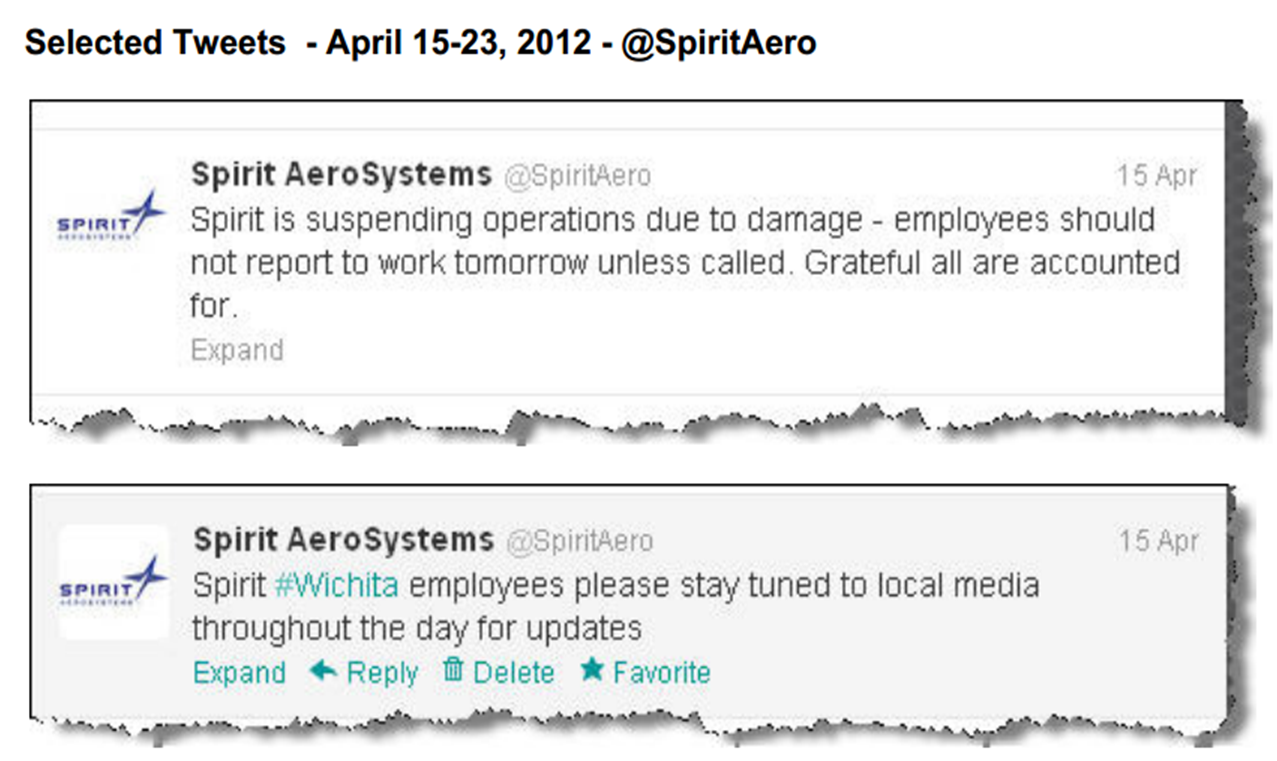Tornado disrupts Spirit AeroSystems’ crisis plan; communicators rally
The EF3 tornado shut down the company’s IT server, so communicators jumped onto Twitter and Flickr to reassure employees and investors that Spirit would be back to normal fast.

On April 14, 2012, an EF3 tornado smashed into Spirit AeroSystems’ world headquarters campus in Wichita, Kan. The winds tore apart 10,000 square feet of roof, damaged equipment and material, and instantly blacked out the tools relied on by company communicators to talk to employees and the public in a crisis.
Spirit’s crisis team understandably hadn’t foreseen the need for a crisis plan for their crisis plan, but they set in motion an immediate, partly improvised campaign that relied heavily on social media to get messages out quickly to workers, vendors, investors, financial markets, customers, and the public:
- Twitter: Team members used Twitter to communicate with employees, investment banks, and the news media. Twitter represented a “significant shift” in the handling of employee and stakeholder communications.
- Flickr: To forestall a drop in its stock price, Spirit’s communication team chartered a helicopter from which its professional photographers could take pictures of the tornado damage. The team posted these pictures on Spirit’s Flickr site.
- YouTube: Spirit’s videographers made two- and three-minute videos for stakeholders, updating them on the recovery every 24-48 hours.
- Gmail and Google: Comms and IR departments used Gmail to tell stakeholders about press briefings and respond to inquiries. The team used Google Docs to host employee FAQs, and to post return-to-work information and instructions for managers.
- Press briefings: The comms team used these to distribute employee safety, reporting, and time-keeping information. The first briefing was held just 12 hours after the tornado hit.
Spirit also set up two controlled site tours of the damage for the news media and government officials, held customer conference calls, and sent employees direct emails by midweek after the disaster.
The results:
- One week after the tornado, 11,000 employees returned to work. Return-to-work messages on social and traditional media channels kept absenteeism to a minimum.
- Spirit’s stock price went down just 1 percent five days after the disaster, partly because of the communications team’s aggressive, many-voiced information campaign.
- Spirit’s largest customers publicly praised the company for its rapid recovery. The state’s largest newspaper, The Wichita Eagle, and local news stations praised Spirit’s PR campaign.
- Chad Cross, KWCH Channel 12 (a CBS affiliate) news director, wrote a testimonial in which he compared the completeness and transparency of Spirit’s crisis communications to that of “another aviation company hit by the same storm, which directed media to call an out-of-state spokesperson. The public asked our newsroom why we weren’t reporting about that company while we had so much coverage of Spirit.”
Spirit’s PR and crisis team comprises 14 people: Ken Evans, Sam Sackett, Randal Allen, Susan Calbeck, Tony Chavez, David Combs, Jarrod Bartlett, Sonja Dove, Carol Howard, Grant Sorenson, Lisa Conklin, Jonathan Van Winkle, Ted Lewis, and Coleen Tabor, all of whom are under the leadership of Debbie Gann, VP of communications and administration at Spirit.
Want to get recognized for your hard work? Find out about Ragan and PR Daily’s award programs here: https://www.prdaily.com/Main/RaganAwardsPrograms.aspx
View More Media Relations Awards 2012 Winners.
Visit Ragan.com/Awards to learn more about awards opportunities.


